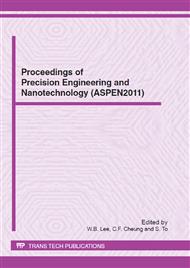[1]
L.C. Clark, Jr., Monitor and control of blood and tissue oxygen tensions, Trans. Am. Soc. Artif. Intern. Organs. 2 (1956) 41-48.
Google Scholar
[2]
J.N. Demas, B.A. Degraff, P.B. Coleman, Oxygen sensors based on luminescence quenching, Anal. Chem. 71 (1999) 793A- 800A.
DOI: 10.1021/ac9908546
Google Scholar
[3]
K. Tsukada, S. Sakai, K. Hase, H. Minamitani, Development of catheter type optical oxygen sensor and applications to bioinstrumentation, Biosens. Bioelectron. 18 (2003) 1439-1445.
DOI: 10.1016/s0956-5663(03)00072-1
Google Scholar
[4]
E. VanderDonckt, B. Camerman, R. Herne, R. Vandeloise, Fiber-optic oxygen sensor based on luminescence quenching of a Pt(II) complex embedded in polymer matrices, Sens. Actuators B Chem. 32 (1996) 121-127.
DOI: 10.1016/0925-4005(96)80120-1
Google Scholar
[5]
S.K. Lee, I. Okura, Photostable optical oxygen sensing material: Platinum tetrakis (pentafluorophenyl) porphyrin immobilized in polystyrene, Anal. Comm. 34 (1997) 185-188.
DOI: 10.1039/a701130j
Google Scholar
[6]
A.N. Watkins, B.R. Wenner, J.D. Jordan, W.Y. Xu, J.N. Demas, F.V. Bright, Portable, low-cost, solid-state luminescence-based O2 sensor, Appl. Spectrosc. 52 (1998) 750-754.
DOI: 10.1366/0003702981944175
Google Scholar
[7]
Y. Tang, E.C. Tehan, Z. Tao, F.V. Bright, Sol-gel-derived sensor materials that yield linear calibration plots, high sensitivity, and long-term stability, Anal. Chem. 75 (2003) 2407-2413.
DOI: 10.1021/ac030087h
Google Scholar
[8]
R.M. Bukowski, R. Ciriminna, M. Pagliaro, F.V. Bright, High-performance quenchometric oxygen sensors based on fluorinated xerogels doped with [Ru(dpp)(3)](2+), Anal. Chem. 77 (2005) 2670-2672.
DOI: 10.1021/ac048199b
Google Scholar
[9]
S.K. Lee, I. Okura, Porphyrin-doped sol-gel glass as probe for oxygen sensing, Anal. Chim. Acta 342 (1997) 181-188.
DOI: 10.1016/s0003-2670(96)00562-4
Google Scholar
[10]
T.S. Yeh, C.S. Chu, Y.L. Lo, Highly sensitive optical fiber oxygen sensor using Pt(II) complex embedded in sol–gel matrices, Sens. Actuators B Chem. 119 (2006) 701-707.
DOI: 10.1016/j.snb.2006.01.051
Google Scholar
[11]
C.S. Chu, Y.L. Lo, High-performance fiber-optic oxygen sensors based on fluorinated xerogels doped with Pt(II) complexes, Sens. Actuators B Chem. 124 (2007) 376-382.
DOI: 10.1016/j.snb.2006.12.049
Google Scholar
[12]
C. McDonagh, B.D. MacCraith, A.K. McEcoy, Tailoring of sol-gel films for optical sensing of oxygen in gas and aqueous phase, Anal. Chem. 70 (1998) 45-50.
DOI: 10.1021/ac970461b
Google Scholar
[13]
B.F. Lei, B. Li, H.R. Zhang, S.Z. Lu, Z.H. Zheng, W.L. Li, Y. Wang, Mesostructured silica chemically doped with Ru-II as a superior optical oxygen sensor, Adv. Funct. Mater. 613 (2006) 1883-1891.
DOI: 10.1002/adfm.200500737
Google Scholar
[14]
X.Y. Wang, C. Drew, S.H. Lee, K.J. Senecal, J. Kumar, L.A. Sarnuelson, Electrospun nanofibrous membranes for highly sensitive optical sensors, Nano Lett., 11 (2002) 1273-1275.
DOI: 10.1021/nl020216u
Google Scholar
[15]
T. Zhang, Q. Zhang, J. Ge, J. Goebl, M. Sun, Y. Yan, Y.S. Liu, C. Chang, J. Guo, Y. Yin, A self templated route to hollow silica microspheres, J. Phys. Chem. C 113 (2009) 3168-3175.
DOI: 10.1021/jp810360a
Google Scholar
[16]
Q. Zhang, T.R. Zhang, J.P. Ge, Y.D. Yin, Permeable silica shell through surface-protected etching, Nano Lett. 8 (2005) 2867-2871.
DOI: 10.1021/nl8016187
Google Scholar
[17]
B.H. Han, I. Manners, M.A. Winnik, Oxygen sensors based on mesoporous silica particles on layer-by-layer self-assembled films, Chem. Mater. 17 (2005) 3160-3171.
DOI: 10.1021/cm047770k
Google Scholar
[18]
J.R. Lakowicz, Principles of Fluorescence Spectroscopy, 2nd ed; Kluwer Academic/Plenum Press, New York, 1999, Chapter 8 and 9.
Google Scholar
[19]
W. Stöber, A. Fink, E. Bohn, Controlled growth of monodisperse silica spheres in micron size range, J. Colloid Interface Sci. 26 (1968) 62-69.
DOI: 10.1016/0021-9797(68)90272-5
Google Scholar
[20]
C.S. Chu, Y. L. Lo, Highly Sensitive and Linear Optical Fiber Carbon Dioxide Sensor Based on Sol-Gel Matrix Doped with Silica Particles and HPTS, Sens. Actuators B Chem. 143 (2009) 205-210.
DOI: 10.1016/j.snb.2009.09.019
Google Scholar


